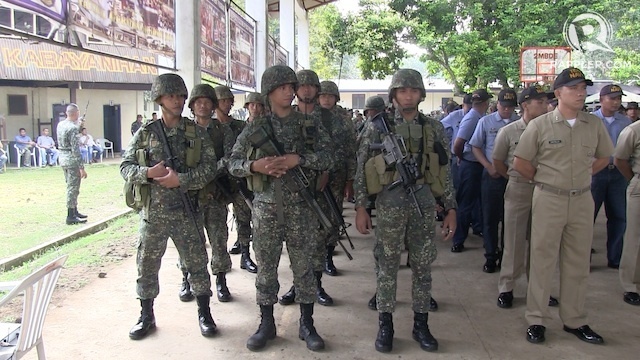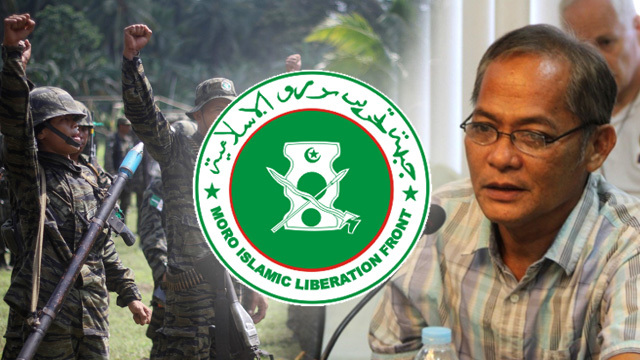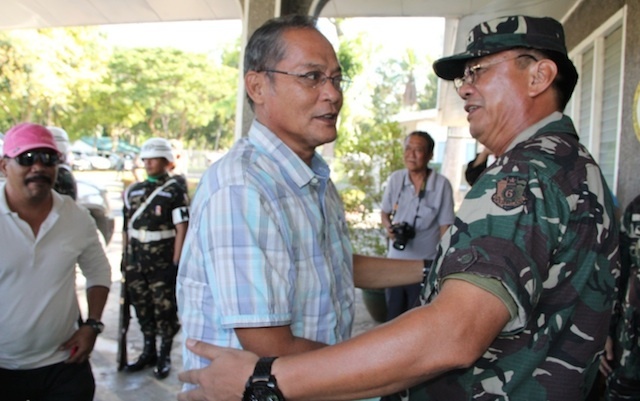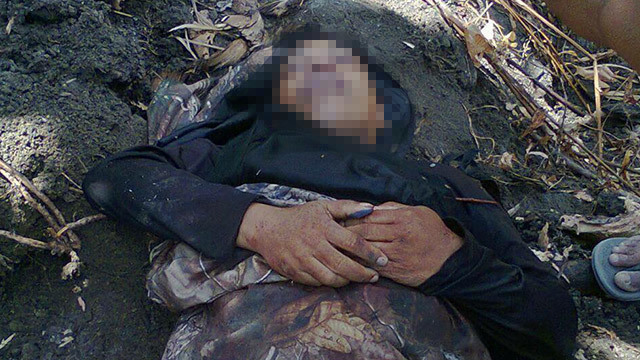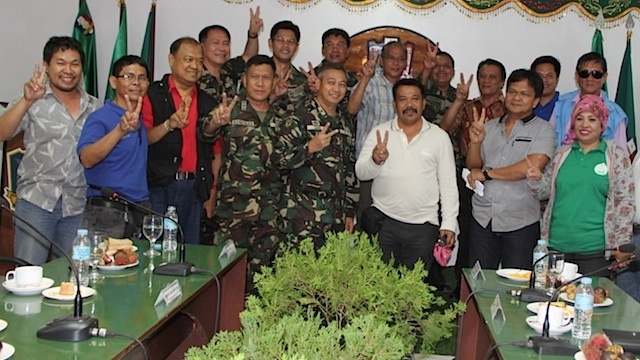From Rappler (May 8):
Wahid Tundok, the controversial MILF commander
It's easy to regard him with suspicion. He and the late BIFF leaders Ameril Umra Kato and Basit Usman go a long way.
 The two stories
that circulated about the death of terrorist Abdul Basit Usman stirred opposing
views from supporters and critics of peace talks with the Moro Islamic
Liberation Front (MILF).
The two stories
that circulated about the death of terrorist Abdul Basit Usman stirred opposing
views from supporters and critics of peace talks with the Moro Islamic
Liberation Front (MILF).
One account said
the MILF killed the commander of the breakaway group Bangsamoro Islamic Freedom
Fighters (BIFF). Another account said MILF members allowed him to hide among
them until he was killed by one of his bodyguards purportedly because of the
bounty on his head.
The first was
celebrated as proof of the MILF's sincerity and commitment to the peace
process. The latter revived questions about the ability of the MILF leadership
to control its members, raising doubts about the future of the new Bangsamoro
region that will be formed.
The details of
Usman's death inside an MILF area that is off limits to the military is
important to establish. It will define MILF Commander Wahid Tundok, a
battle-hardened warrior responsible for horrifying violence in the past decade,
but upon whom the success of the next phase of the peace process now heavily
lies.
“He is very
instrumental to the peace process since he has the respect of more than 3,600
fighters," said a military officer on the ground, referring to MILF armed
regulars who are now staying in relocation areas to avoid the military
offensive against the BIFF.
Rappler put
together this profile of Tundok based on accounts of military and intelligence
officers, MILF representatives, public statements accusing him of several
crimes, and various reports on incidents in Maguindanao that involved him.
Ustadz
Tundok a coddler?
The charismatic
and soft-spoken commander of the 118th MILF Base Command (BC) is one of the
most revered fighters of the MILF-Bangsamoro Islamic Armed Forces (MILF-BIAF).
His influence over local people is boosted by his stature as an ustadz or
religious leader.
He is responsible
for certain areas of the MILF stronghold, Maguindanao, including barangays
bordering the cornfields of Mamasapano town, where 44 elite cops died in the
January 25 operation that killed Malaysian terrorist Zulkifli bin Hir or
"Marwan.”
He is also
responsible for Camp
Afghan in Guindulongan
town, one of the relocation sites for MILF fighters, where Usman was killed 3
months later.
He has long been
accused of being the coddler of both Marwan and Usman. The police claimed he
even joined the bloodbath in Mamasapano in January.
These are
allegations that the MILF denied. Tundok's only
fault – according to an MILF report – is failing to detect the presence of
two of the most wanted terrorists among them. The US put a $5-million bounty on
Marwan's head and $1 million on Usman's.
The men
of the 105th
There is no
debate about his past. When the MILF was still fighting for Muslim
independence, Tundok's notoriety among security forces was second only to the
late Ameril Umra Kato.
Kato, who formed
the BIFF in 2010, was Tundok’s commander at the 105th MILF BC.
It's the MILF-BIAF's fiercest fighting unit, composed of radical Islamic
militants, that inflicted heavy casualties on the military.
Together they
fought the government forces in the 2000 “all-out war.” They were tagged by the
police in the 2005 attack of a military detachment in Mamasapano that killed 10
Army soldiers. They also wreaked havoc when the peace agreement under President
Gloria Arroyo was declared unconstitutional in 2009.
To this day, the
mention of Tundok's name can spark angry curses from soldiers who have survived
his attacks.
Usman was also a
combatant of the 105th, according to some officers on the ground, but he would
earn a reputation much later when he joined the MILF Special Operations Group
and learned bomb-making. Unlike Tundok and Kato, Usman was more of a
"bomber-for-hire" than a leader who inspired men to follow him.
Peace talks under
the administration of President Benigno Aquino III brought them to opposite
paths, although all 3 remained in Maguindanao. Kato continued to fight the
government along with Usman and his other loyal men in the 105th.
Tundok may have
likely joined the BIFF, too, and brought with him his most loyal men if he
wasn’t courted intensely by the MILF leadership to stay with the MILF and
support the peace process, according to two government sources.
The 118th MILF BC
was activated and Tundok was put at the helm to "counterbalance” the 105th
and divide the fighting unit that has become too powerful and too dangerous.
The areas of the 105th and 118th overlap, based on military maps.
FRIENDS. A file photo of MILF Commander Wahid Tundok visiting the 6th Infantry Division headquarters on March 1, 2014
Short of
admitting that Tundok did coddle them, government sources acknowledge that the
3 former warriors of the 105th BC have maintained mutual respect for each other
and the BIFF continued to court Tundok to join them.
"It would
have been a major problem if Tundok joined the BIFF," said a military
general.
Tundok, Kato, and
Usman characterize the prevailing relationship among MILF and BIFF members who
disagree on the peace process but remain as neighbors, if not relatives, and
continue to live peacefully together.
"Mahirap
ang word na coddling. If you're in his place, magkakapit-bahay kayo. Tandaan
mo, may rido sa kanila. What they have is peaceful co-existence," said an intelligence officer. (It's
difficult to use the word 'coddling'. If you're in his place, you're neighbors.
Remember, they practice rido [or clan war].)
"Haram
sa Muslim na patayin mo ang kaibigan mo (It is forbidden among Muslims to
kill their friends)," added another officer.
Advocates of the
peace process said this is the reality on the ground that lawmakers have to
understand when they judge Tundok and his role in the peace process.
It’s a reality
that military officers have to contend with. It’s the same
reason why it’s difficult even for some military officers to believe
that Tundok will order his men to get Usman.
"If Tundok
really wanted Usman arrested, matagal na niya ginawa, (he would have
done it long ago)," said the officer who first narrated to Rappler the
supposed infighting among Usman's bodyguards. The MILF supposedly just found
the dead bodies when they arrived at the scene.
Deliberate
confusion over Usman's death
But Tundok did
order his men to get Usman, according to the MILF. The military also retracted
its report that Usman’s bodyguard shot him. (READ: MILF
killed Usman – AFP chief)
MILF vice
chairman for political affairs Ghadzali Jaafar said Usman’s death is a
vindication for Tundok. "Hindi totoo na tinago ni Wahid Tundok si
Usman. Kung siya ang nagtago bakit unit niya ang humuli kay Usman?"
Jaafar said. (It's not true that Wahid Tundok protected Usman. If he was hiding
him, why was it his unit that captured Usman?)
"Definitely
hindi kikilos ang mga tao sa 118th BC kung hindi galing kay Tundok ang
command," Jaafar added. (The men of the 118th BC will not move if the
order did not come from Tundok.)

But there are too
many versions of Usman's death it's hard to tell who's telling the truth. Even
the MILF floated two scenario.
“Forget the story
about the bodyguards. They’re probably trying to prevent a rido,” said a
source on the ground, laughing at the confusion that ensued.
While some camps
have dismissed the official account as propaganda to build up the MILF and push
for the passage of the law that will implement the peace agreements, a military
officer on the ground said the confusion is deliberate and meant to confuse Usman’s
relatives and followers who plan to avenge his death.
Tundok's
choice
Intelligence
officers confirmed to Rappler the MILF statement – that the MILF Central
Committee ordered its members to arrest Usman. This was the
"compromise" with President Aquino, one of the sources said.
In the end,
Tundok did not have a choice. He would not dare to defy the orders of MILF
chairman Murad Ebrahim, who is also known among the MILF for being strict.
"Hindi mo
pwedeng suwayin si Murad," said a military officer. (You cannot defy
Murad.)
One of the
sources said Tundok had long warned Usman to stop his activities and stay away
from his territory, but the military offensive had also limited where the BIFF
commander could go. On May 3, he was forced to enter the vicinity of Camp Aghan
while he was on the run. He thought he was safe there but not anymore.

PEACE SIGN. Philippine military officers and MILF leaders including Wahid Tundok pose for peace.
In the aftermath of the Mamasapano tragedy, some camps blamed the peace process for keeping the military from immediately using its arsenal to crush the MILF involved in the bloodbath and prevent them from decimating the elite cops.
Drowned in the debate is the fact that the war-torn communities have enjoyed relative peace because MILF commanders – most especially Tundok – and their men chose the peace process and agreed to silence their guns, while the MILF Central Committee tried to forge an agreement with the government.
At the height of the blame game and Manila's call for Tundok's head, a military general recalled how he feared that Tundok might be forced to join the BIFF if the government went after him.
His arrest in February 2014 gave a glimpse of the chaos that Tundok can cause. The police was implementing an arrest warrant for a crime Tundok committed before the peace talks.
While the MILF slammed the arrest as a violation of the immunity clause in ceasefire agreements, on the ground, the rebel group scrambled to call for cooler heads among the already-agitated fighters.
The arrest came as the rebel group and the government prepared to sign a final peace pact in March. Malacañang gave in to prevent the situation from exploding on the ground and to prevent a collapse of the peace process.
Convinced that Tundok had an important role to play, the arrest warrants were recalled and he was released.
In the most important and most difficult phase of the peace process, Tundok was offered the chance to redeem himself. It would take a revered and respected fighter like him to persuade thousands of MILF fighters to lay down their arms.
"He will be instrumental in the decommissioning process since he made a commitment to the normalization process,” said a military general.
The military source is confident that Tundok will deliver. Perhaps only then can his critics overlook his past.
http://www.rappler.com/newsbreak/in-depth/92528-controversial-milf-commander-wahid-tundok



